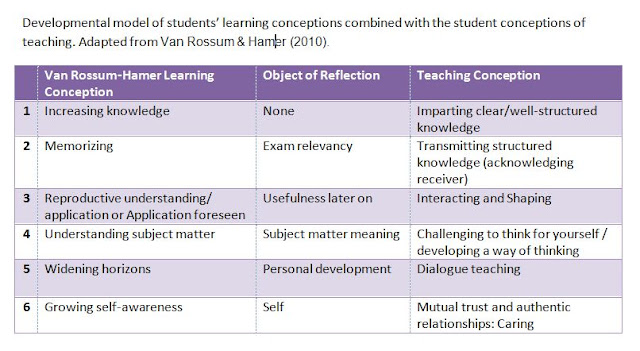Learning is extremely individual, situational and contextual! One thing is granted, though: learning involves a change. How we perceive learning depends on the learning theories we believe in. See this post for further discussion about that: The Big Picture
Each individual learning experience is different because what we each see/hear/think depends on our previous experiences and the unique filters we have. Thus, while presented with the same information we process it in diverse ways. Even in a collective learning situation we all are engaged also in our own personal learning process. Understanding that learning and teaching are not the two sides of the same coin is the beginning. Students learn all the time, but they may not be learning things we wanted them to learn.
Effective teaching is much more than just instruction. It is helping students engage with their own learning process, and thus also requires handing over the tools of learning to the students: choices, self-assessment and -regulation, metacognitive strategies, goal-setting, and much more. This doesn't mean teaching becoming obsolete - what is needed is simply just a change of focus in the practice. A step towards student centered learning. Supporting the learning process requires the teacher to become a learning facilitator instead of being the source of information. See this post why knowledge cannot be transmitted: Information is shared, knowledge is constructed.
When students are empowered to be in charge of their own learning process, they are also accountable for their own learning. After all it IS students' job to learn, and teachers' job to help students in learning. We cannot do it for students, every student must use their own thinking to engage with the materials and learn.
When learning is perceived as a product something very valuable is lost: the open-ended curiosity that drives students to learn more than what is mandated. Many scholars have described the same curiosity in different terms depending of their frame of reference: passion, element, purpose, and of course also having the intrinsic motivation to learn.
If learning is just a product: an essay, a perfectly filled work sheet, or an objective exam with closed questions one important part of learning is excluded - creativity. Please note that I am not only talking about the artistic ability to create, but hoping for students to have opportunities to apply their critical thinking skills, because we use the same problem solving skills in different situations, starting from social conflicts in early childhood and also while being engaged in the creative process.
While following the thinking of someone else we will never create the same competence as we do while thinking it through with our own brain! The copied thinking - just like a copied product - only leads to surface learning, which doesn't have much chance to be stored permanently in students' brain. Emphasizing the product over the process can really backfire in the classroom
Please visit NotesFromNina for questions whether learning is process or a product!









